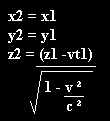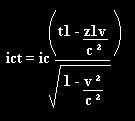Time Travel Research Center © 2005 Cetin BAL - GSM:+90 05366063183 - Turkey / Denizli
Mathematics of Time Travel
The Lorentz Transformations: according to relativity theory the length of a body as measured by an observer in uniform relative motion is less than that measured by an observer at rest with respect to the body. There's not a physical change in the body, but a consequence of the Lorentz Transformation. For simplicity it has been assumed throughout than Z is the direction of motion, consequently:

Where i = square root of -1

This Lorentz invariant applies to the four vectors: distance, velocity, acceleration and momentum and each will be discussed below:
Distance

Velocity
In Newtonian mechanics velocity
is derived by differentiating the position with respect to time. The relative
nature of time in Einstein's relativity appears at first glance to pose
something cause problem. The solution is to use the "proper time", i.e. the time
measured by an observer attacks to the moving object. This has the advantage
that the differences in x, y and z are zero nd that the "proper time" is
orthogonal to the other three axes; which is an intrinsic properly of "proper
time" Newtonian mechanics, considered as the fourth Euclidean
ordinate.
Differentiating using the proper time gives the four-velocity
expression below, where uu is the familiar three-space velocity of
Newton:

Acceleration
Again, this is obtained by differentiating the four velocity with respect to the "proper time" giving A = (a, 0) where a is the three-space acceleration of Newton.
Momentum
The Lorentz Transformation invariant four momentum expression where p is the magnetude the three momentum of Newtonian mechanics is shown below. The conservation both of the three momentum and of mass energy is contained within the conservation of four momentum:

Dirac's Derivation of Negative Mass Energy: In classical Newtonian physics the energy E of an object is given by:
![]()
Where m is mass and v is
velocity. As both mass and any quantity squared must be positive, energy also
must be positive. Classical Newtonian momentum is simply the product of the mass
and the velocity.
Both classical energy and momentum are conserved. In
relativistic Einsteinian physics, four momentum, P, is of the form (px, py pz,
iE/c). It is now this four momentum, momentum energy that is conserved. As a
vector its magnetude is Lorentz invariant. If in one frame of reference the rest
frame, an object is at rest then:
P² = m²oc²
Where m is now the rest mass. In a frame in which it is moving then:
P² = p² - E²
ccccccacc²
Where p is just the magnitude of Newton's three momentum, and E is the corresponding energy. Each component of P is conserved, which consequently implies the conservation of both mass energy and momentum, similarly to Newtonian mechanics. Additionally, as P is invariant, the last two equations must be equal, i.e. after rearranging:
![]()
We are at liberty to take either the positive or negative square root of the right hand side for energy; the latter of these gives rise to negative mass energies.
Hiçbir yazı/ resim izinsiz olarak kullanılamaz!! Telif hakları uyarınca bu bir suçtur..! Tüm hakları Çetin BAL' a aittir. Kaynak gösterilmek şartıyla siteden alıntı yapılabilir.
The Time Machine Project © 2005 Cetin BAL - GSM:+90 05366063183 -Turkiye/Denizli
Ana Sayfa / İndex / Ziyaretçi
Defteri / ![]() E-Mail / Kuantum Fiziği / Quantum Teleportation-2
E-Mail / Kuantum Fiziği / Quantum Teleportation-2
Time Travel Technology / Kuantum Teleportation / Duyuru / UFO Technology /